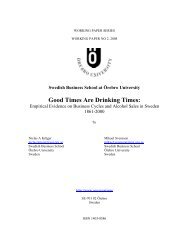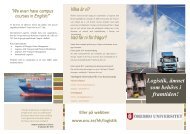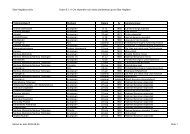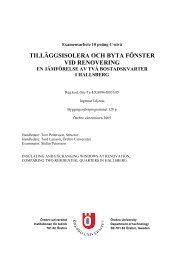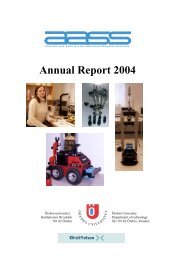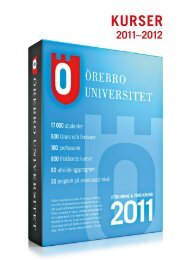Annual Report 2002 - Ãrebro universitet
Annual Report 2002 - Ãrebro universitet
Annual Report 2002 - Ãrebro universitet
You also want an ePaper? Increase the reach of your titles
YUMPU automatically turns print PDFs into web optimized ePapers that Google loves.
34 AASS – Center for Applied Autonomous Sensor Systems<br />
2. Research Labs<br />
At the present time AASS consists of four research laboratories that have joined their<br />
expertise to cover and integrate the broad spectrum of scientific disciplines needed for the<br />
design and implementation of industrially relevant autonomous systems.<br />
This would be practically impossible for any individual laboratory, but is achievable by a<br />
joint effort, which is organized in the form of AASS. This joint effort is aimed not only at<br />
expanding the frontiers of the science of autonomous sensor systems, but also gradually<br />
incorporating it in the graduate and undergraduate curriculum, and producing physical<br />
demonstrators of autonomous sensor systems with industrial and educational relevance.<br />
The common scientific denominator for the four research laboratories is the subject of<br />
"perception and autonomy in diverse un- and/or semi-structured environments''. We<br />
pursue this subject using a common research methodology, which is strictly applied: all<br />
technologies that we investigate should answer actual needs that emerge from an application,<br />
and their effectiveness is always validated on the application.<br />
2.1 Biologically inspired systems lab<br />
The lab’s research addresses the development of human-like (or more generally biological<br />
systems like) sensors/actuators and biologically inspired methods for sensori-motoric<br />
information processing, fusion and perception. With respect to perception, the objective is to<br />
incorporate in the design of intelligent sensors biologically inspired features (human-like) of<br />
perception (granularity, uncertainty, imprecision and vagueness), and make a reference to<br />
anatomical localization and biological functions. Regarding sensori-motoric motion control,<br />
our concern is the investigation and development of totally neurobiologically inspired,<br />
adaptive and intelligent control schemes for visually guided reach, grasp and dexterous<br />
manipulation by means of an anthropomorphic hand actuated by artificial muscles. This<br />
research direction takes also into account the study of arm-hand coordinated movements,<br />
which could be driven by a combination of different types of artificial muscles and/or muscle<br />
like actuators.<br />
Achieving the above objectives would provide on one hand more reliable, robust and accurate<br />
quality testing and assessment devices for purely industrial applications including the food<br />
industry and intelligent rescue systems; on the other hand, it contributes to the improvement<br />
of our current understanding about the behavior and functioning of biological control systems<br />
namely the central nervous system. This is essential for designing artifacts that help humans<br />
to avoid repeated unskillful and dangerous tasks.





